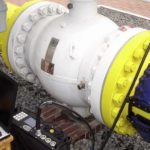
In Guided Wave Ultrasonic Testing of pipelines, an array of low frequency transducers are attached around the circumference of the pipe to generate an axially symmetric wave that propagates along the pipe in both forward and backward directions. At a location where there is a change of cross-section or a change in local stiffness of the pipe, an echo is generated from which the location and severity of the defect can be assessed. The data can typically be analysed on-site so that any complementary inspections that are required can be performed immediately.
Guided Wave Ultrasonic Testing is fundamentally very different from conventional Ultrasonic Testing. The method uses very low ultrasonic frequencies compared to those used in conventional UT. The torsional guided wave mode is highly sensitive to most defect types while experiencing low attenuation in most situations, making it ideal for the inspection of a long length of pipework. In addition, the testing instrument is able to withstand extreme weather conditions, while the technology requires limited access when compared to conventional testing forms and has the capacity to inspect road crossings and buried pipe with minimal interference required.
In terms of reporting, an automatic reporting feature is available which allows for increased productivity. All raw data is stored by AMOSCO for later review and auditing, while reports can be printed directly or imported into other applications depending on AMOSCO client preferences. Photographs can also be readily embedded into report files.







